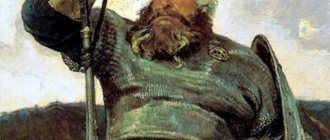Research project “Three heroes of the Russian land”
- Great Russia__________________________________________ 3
- Ilya Muromets_________________________________________4-6
- Dobrynya Nikitich________________________________6-7
- Alyosha Popovich________________________________________________7-8
- Conclusion_________________________________________________8-9
- List of used literature______________________________9
Introduction
Russia is a great country! We all love her very much and of course any boy, like a real man, knows that in case of danger and necessity he must stand up for her! Every boy dreams of becoming a hero of his country. But who are the heroes? They are all so different. Someone conquers space, someone defends their homeland on the border from enemies, and someone invents a new medicine that will help cure many people. And I wanted to know about the first heroes - Russian heroes.
The goal of my project:
— Restore the history of the real life of the heroes.
Project objectives:
- Study literature on the topic of the project.
- Find out whether the heroes actually lived.
- And at present, who can be considered a hero?
Relevance
: The study of this topic is determined, first of all, by the fact that Russian heroes are an example of courage and valor, a standard of patriotism.
Project hypothesis
: did the three heroes really exist or did someone make them up?
1. Great Russia.
Many, many years ago our country was called not Russia, but Rus. And many different peoples lived on its territory. The Russians lived amicably, worked well, but the enemy was not asleep and constantly raided our people in order to seize our territories and wealth. He took women and children captive, forced them to work as slaves, and killed men.
But every time there were new brave men who stood up against the enemy, because they believed that courage and strength would defeat the enemy. And the three heroes were their examples!
Bogatyrs were called strong, mighty warriors who could easily cope with the most terrible enemy. They defended their native land, performed feats, and truly served the Grand Duke.
Who among us has not heard of them - Ilya Muromets, Dobrynya Nikitich and Alyosha Popovich. And everyone, of course, saw the painting “Three Heroes” by the artist Vasnetsov.
So who are they, the heroes? 2.
Ilya Muromets.
The most famous, of course, is Ilya Muromets. The epics say that Ilya lay on the stove until he was 33 years old and did not get up. Do you think he was lazy? No, Ilya simply suffered from a spinal disease and was paralyzed; he could not move, which is why he lay on the stove.
Numerous attempts to cure him were unsuccessful. On the day when Ilya turned 33 years old, local elders healed him. The elders came to his home and ordered him to drink medicinal water. Ilya drank and recovered. After the second drink, he felt an exorbitant strength in himself, and then he was given a third drink to reduce it.
After a miraculous healing, Ilya Muromets says goodbye to his parents and goes to serve Prince Vladimir the Red Sun. The hero did not have a family; he lived alone for a long time, then went to a monastery.
It is known that Ilya was 182 centimeters tall; the average height of adults at that time was no more than 160 centimeters. For the people of that time, Ilya Muromets looked approximately the same as for us the famous strongmen capable of moving a loaded truck or a medium-sized plane.
Our hero became famous in Germany. Ilya traveled to foreign lands and became famous there for his strength and courage!
Scientists have established the cause of Ilya’s death - he died from a spear blow to the heart - the spear also pierced the hero’s left hand.
3. Nikitich
.
The birthplace of Dobrynya is considered to be the city of Korosten, Zhytomyr region. After the city was burned by the army of the Russian princess Olga, 10-year-old Dobrynya and his sister were taken prisoner. He experienced a lot of humiliation from people; more than once Dobrynya had to respond to insults and stand up for her sister. We can say that it was then that he developed the character of a warrior. The carpenter made a wooden sword for Dobrynya, and in the evenings, and even at night, he practiced martial arts. And he learned sword techniques from the warriors when he watched their teachings in his free time.
When Dobrynya grew up, he was assigned to the princely squad. They decided to test the newcomer and forced him to fight with an experienced and skilled warrior. Imagine the surprise of the warriors when Dobrynya knocked the sword out of his hands with his own technique!
Historians are confident that in reality the hero Dobrynya never existed, the Russian people simply invented this hero. They even gave the hero his name “Dobrynya”, from the word “good”. They wanted the heroes to be not only strong and brave, but also kind. How the hero Dobrynya Nikitich died is unknown. The most famous feat of Dobrynya in epics is the fight with the Serpent-Gorynych.
4. Alyosha Popovich
.
We know the least about the third hero - Alyosha (or maybe Alexander) the priest's son. In the epics, Alyosha is not described as a hero with extraordinary strength. Quite the contrary - he is weak and limps. But God gifted him with ingenuity, cunning, and intelligence. Alyosha Popovich played the gusli well. He could deceive, he could brag and do things on the sly. His jokes could be funny, or they could be evil.
In epics, when the hero Alyosha Popovich was born, thunder roared. Even as a baby, he asks his mother to be swaddled not with swaddling clothes, but with chain mail. When he was very young, he asked for blessings to go for walks around the world. Alyosha, it turns out, can already handle a horse and a weapon.
One of the most popular epics was “Alyosha Popovich and Tugarin.” It describes how Alyosha defeats the evil hero Tugarin. He died heroically in 1223 in the battle on the Kalka River.
In epics and legends, three heroes often perform feats together. But in fact they never met, because they lived at different times and served different princes. Yes, it doesn’t matter to people whether the heroes actually existed or not, what time they lived, the main thing is the exploits of the heroes!
After all, every person who learns about these heroes develops pride in their country and a desire to be like them.
CONCLUSION
I think that even today Russian heroes are an example of courage and valor, a standard of patriotism. I learned that based on the example of such epic heroes, real heroes grew up in our village. For example, Sergei Alexandrovich Davydov. He was an ordinary boy who went to school, just like you and me. Born on April 3, 1962 in the city of Ardatov, Mordovian Autonomous Soviet Socialist Republic. Russian.
He studied at Sabur-Machkassky vocational school No. 2, Chamza district. He was drafted into the Armed Forces of the USSR on May 4, 1980 by the Chamza District Military Commissariat. In the Republic of Afghanistan since November 1981, private, senior driver. The unit in which he served returned to its place of deployment after completing a combat mission. The column on the march was fired upon. For more than 2 hours the soldiers repelled the attack. In the battle, Sergei Davydov acted boldly and decisively, was wounded twice, but did not leave the battlefield until reinforcements arrived. During evacuation to the hospital he was wounded for the third time. On February 10, 1982, he died in hospital from his wounds.
For courage and courage he was awarded the Order of the Red Star (posthumously).
He was buried in the village of Komsomolsky, Chamzinsky district.
One of the streets in our village is named after him.
May 7, 1995 - in the 1st microdistrict of the village of Komsomolsky, an obelisk was erected in the form of four steel pylons, on each of which the names of those killed in Afghanistan were carved.
2002 - a memorial sign was unveiled at the Eternal Flame in the village of Chamzinka - a memorial stele to the fallen soldiers - Afghans.
I believe that my hypothesis: whether the three heroes actually existed or someone invented them, is true for every assumption. Real people who could be called heroes existed, but the three heroes are a collective image of the heroes of the Russian land.
List of used literature:
- Asbelev, A.P. “Dobrynya Nikitich - governor of Prince Vladimir” // M.: Languages of Slavic culture, 2000.
- Likhachev, D.S. Dobrynya Nikitich and Alyosha Popovich // M.: 2005
- Miller, M.F. Epics: myths and reality // M.: Languages of Slavic culture, 2002.
- Milyushov, A.S. “History of Melekessko-Dimitrovgrad streets”, 2011
- Russian heroes: epics. In the retelling for children by I.V. Karnaukhova//M.: “Children’s Literature”, 2006.
- https://literatura5.narod.ru/bogatyri.html
- https://slavyanskaya-kultura.ru/slavic/folk/pro-bogatyrja-ilyu-muromca.html
Cartoons
A cartoon is a model of the world around us, so children tend to imitate what they see on the screen. We live in a century of new technologies, and accordingly, cartoons have become completely different. What kind of modern cartoons are they? What do they bring into our lives, what do they teach us?
Is it possible and worth watching all cartoons without restrictions? Why do parents allow me to watch some cartoons, and watch them with pleasure, while others don’t, even if they have such bright, colorful and cheerful characters. All children are literally in captivity of the animation. Many children and teenagers refuse to play, walk in the fresh air and communicate with friends, preferring to sit for hours in front of the TV.
What attracts teachers and parents to Soviet cartoons? Cartoons are a real find: as we know, for the most part they teach a child kindness, sincerity, devotion, the ability to value friendship and other qualities important for the harmonious development of a person. The high value of the “right” act, the idealization of honesty, spirituality, morality - all those qualities that each of us wants to instill in our children.
WARRIOR
The image of a female hero is unusual for Russian epics. On the one hand, life in Ancient Rus' inevitably required both strength and ingenuity from the fair sex. On the other hand, the society was rather patriarchal. Therefore, heroic battles and brave deeds were considered more the lot of men than women. However, either as an inheritance from the once existing matriarchal communities, or as a sign of respect for the Russian Maryas and Vasilises, in the Slavic epic you can find several bright heroines who travel around the world to gain military strength for themselves.
Moreover, they have such heroic power that even great warriors do not always manage to cope with them. One of the most striking examples is Nastasya Mikulishna.
What are "epics"?
While studying the concept of “epics” on the Internet, I found that epics are Russian folk songs that tell about the heroic deeds of courageous heroes. They often describe heroic events and exploits in which the people took part. The word “epic” means “old times,” that is, something that happened far in the past. The epic as a literary genre is not subject to reliable accuracy.
Epics tell about invincible Russian heroes - and this is also true. Glorifying the heroes, the defenders of the Motherland, the epics called for heroic deeds for the glory of the fatherland, raised the spirit of the people in difficult years of trials, and instilled in their youth love for their native land and hatred for their enemies. The example of invincible heroes instills courage in people, strengthens the sense of duty and honor. There is not a single epic where the hero, a warrior, did not defeat the enemy.
There were a large number of heroes in Rus'. Some were more famous, others less famous. Some were made into films and series of cartoons, while others I only read about in books, and even then in very small stories. I decided to explore the life of three heroes. Two little-known ones, such as Mikula Seljaninovich and Churilo Plenkovic. And one powerful hero about whom legends were made - Ilya Muromets.
They were separated by centuries - Mikula Selyaninovich lived in the 9th century, Ilya Muromets in the 12th century, and Churilo Plenkovich in the 15th century. But when legends are passed down from one generation to another for centuries, they acquire new details, famous characters begin to perform new feats, and time frames gradually blur and shift.






